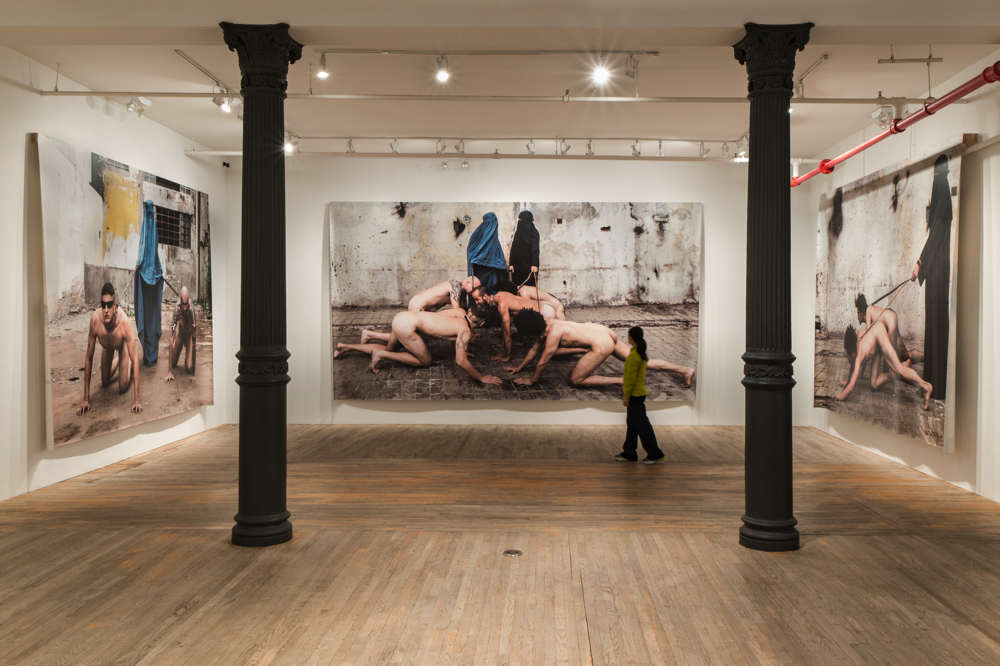KATARZYNA KOZYRA
Bipeds and Quadrupeds
April 27 – June 1, 2019

Kataryna Kozyra, Bipeds and Quadrupeds, 2019 installation view.
"I like some animals more than some people, some people more than some animals."
- Jane Goodall
Postmasters Gallery is pleased to announce a solo exhibition of the prominent Polish artist Katarzyna Kozyra.
As early as her breakthrough work Pyramid of Animals (1993) Kozyra has made the interdependent relationship
of people and animals the focus and the metaphorical tool of her practice. For her sixth exhibition at Postmasters
Kozyra presents a survey of important projects centered on human/animal power dynamics and culminating
in the most recent photographic series, Homo Quadrupeds (2018)
Kozyra is, first and foremost, a creator of striking, complex, photographs, videos and performances where the symbols
of subjugation and oppression have been intentionally complicated and jarringly re-presented in ways that make us
question our assumptions of what is right, what we know, what we expect, and what we put up with.
She infiltrates, observes and documents the worlds to which she does not naturally belong - like in her Venice Biennale
winning installation "Men's Bathhouse" (1998), where disguised as an androgynous boy, she entered
men's baths and secretly filmed the scenes inside. Or like in "Punishment and Crime (2002)
, where she befriended Polish weapons enthusiasts and filmed their violent proceedings. Or like in "Looking for Jesus"
(2012-2018), where she found and interviewed men who consider themselves the Messiah, in and around Jerusalem.
In chronological order the works on view are:
Pyramid of Animals (1993) was inspired by the Brothers Grimm fairytale Town Musicians of Bremen, and consisted of
taxidermied animals: horse, dog, cat and rooster, accompanied by film footage of the horse's slaughter. At the time of
its making, the piece stirred up an unprecedented scandal in the media, which turned it into the most famous Polish
artwork of the last quarter-century. It is in the collection of Zacheta National Gallery of Art. Here Pyramid of Animals is
represented by a newly published vintage photograph.
Lou Salomé (2005) is a video and a photographic series which likens humans to animals - and animals to humans.
In Lou Salomé, Kozyra portrays the titular Russian-born intellectual and femme fatale who was a friend of Friedrich
Nietzsche, Sigmund Freud and Rainer Maria Rilke. Salomé leads Nietzsche and Rilke, chained and leashed like dogs,
through the halls and gardens of the Schwarzenberg Palace in Vienna. Realized in 2005, Lou Salomé is being exhibited
publicly in its entirety for the first time.
The video A Dream of Linnaeus' Daughter (2018) was shot in Uppsala, Sweden, in the gardens of Carl Linnaeus,
the famous 18th century botanist and taxonomist. Kozyra, in the role of Linnaeus' botanist daughter Elisabeth
Christina von Linné, conducts an animal choir singing Beethoven's iconic Ode to Joy. As they stand on wooden
pallets symbolizing Noah's Ark, the moos and squeals of her dog, donkey, cow, horse, goat and monkey choir
fill the garden with what now is the anthem of European Union.
Central to the exhibition is the series Homo Quadrupeds (2018), presented as monumental ten foot-tall prints
of naked men harnessed and led on leashes by burka-clad women. Testing the limits of cultural appropriation,
Katarzyna Kozyra adopts the Burka as a symbol of female oppression, an instrument of restriction, one that
literally renders a woman invisible. But it is men as dogs, in their full body splendor, tattooed and muscular,
that are shown subdued and subordinate. The fields are not just leveled, but inverted; and the women's place
on the male-dominated planet, especially in the context of #metoo, is subverted. In the photos the dogs sniff
each other ready to fight. It is no longer only a matter of liberating women from male domination, as in, for
example, VALIE EXPORT and Peter Weibel's 1968 performance Aus der Mappe der Hündigkeit (from the
Portfolio of Doggishness), in which Weibel heels obediently at the artist's side. Here even though the men
are dominated, they also remain beholden to their violent, competitive, rivalrous instincts, straining against
their bonds, not to be free, but only to fight against each other.
In her "Cyborg Manifesto" (1985) Donna Haraway wrote: "Biology and evolutionary theory over the past two
centuries have simultaneously produced modern organisms as objects of knowledge and reduced the line
between humans and animals..."
In Kozyra's universe bipeds and quadrupeds are equal. Her animalism reveals the truth (we are animals),
while challenging the self-satisfying superiority that animalistic poses can infer. The complacent hierarchies
of people and animals can be reversed. The fairy tale camaraderie of the animals of the Pyramid is countered
by their deaths, all at human hands. The choir of humans in Linnaeus' Daughter sing as if possessed by animal
voices. Upending the contours of the human-canine relationship (as in Haraway's subsequent theory of Companion
Species), gendered power reversal comes to the forefront, as Lou Salomé brings to heel the brightest talents of her
time and the anonymized, burka-clad women yank the chains of their male dogs.















